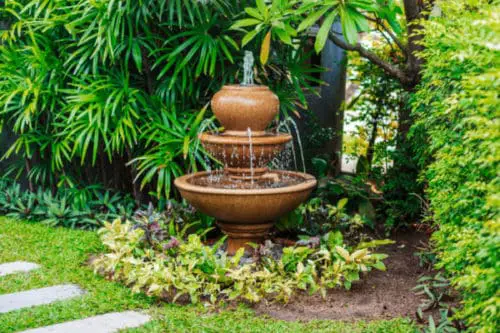Fountains are things of beauty whether inside or out! However, sometimes indoor and outdoor fountains should not be mixed. Here’s why:
All fountains are designed for different environments which is why they should not be interchanged. Outdoor fountains are built sturdily so they can withstand all kinds of weather. They operate differently than indoor fountains and may not be compatible with indoor electric sources.
There are pros and cons to both kinds of fountains. Knowing them will help you decide which one to go with and why they should stick with their respective environments.
Outdoor Fountains
As said above, outdoor fountains are far more sturdy than indoor ones. They must be able to withstand the elements, which include moisture like rain and snow, sun, and wind. Most outdoor fountains are built out of stone which is less prone to damage and wear than wood, glass, or metal.
Outdoor fountains also tend to be much larger than indoor ones since there is typically more space to work within your yard than in your house. This is a large reason they cannot be used inside. The electrical parts are much larger and bulkier which will increase the risk of tripping and damage.
Since they are designed for the outdoors they also don’t have much splash protection. A lack of splash protection inside could be disastrous because it will lead to ruined carpet or wood floor, plus a wet floor can also be a bit dangerous.
Many outdoor fountains nowadays are hardwired or solar powered which simply won’t work for inside. They also tend to require a lot more attention and construction. Many outdoor fountain features are similar to those of outdoor ponds which can withstand a great amount of splashing and wear.
There are definite perks to having an outdoor fountain. What better attraction could you have than a fountain gurgling cheerfully in your garden? Water features are always fun to look at and occasionally play in. An outdoor fountain can be a great focal point for your yard. On top of that, they can be totally unique. They are completely customizable and come in different styles and colors.
Though the perks are worthwhile, there are still a few cons to having an outdoor fountain. For one, they attract pests. Rats, birds, and insects will likely be attracted to your fountain which can be a nuisance, especially if the birds are leaving feathers and feces, or it becomes a breeding ground for mosquitos.
Fountains also require a great deal of maintenance. The pump has to be regularly cleaned and checked for broken parts and clogged filters.
Indoor Fountains
Indoor fountains should not be used outside either, for obvious reasons. They are built differently than outdoor fountains. Their designs don’t include anything that will protect them from the wear and tear of the elements.
An indoor fountain, if put outside, will quickly get dirty, become worn from the weather, and malfunction sooner than later. Debris combined with pests and all that mother nature can bring will ruin a fountain in no time if it has not been designed for the outdoors.
An indoor fountain can be nice though. Running water is a relaxing sound that can help improve your sleep and possibly even lower your stress levels. If the water is oxygenated enough, it can even help improve the air you breathe. The only things you would need to worry about are small children and leakage.
Kids are curious. A water feature can be a safety hazard if your kids are young enough, so be sure to put your indoor feature somewhere the kids won’t be tempted by it. Water damage can also be devastating if it remains unchecked. Be sure to check for leaks in the fountain’s system to prevent any damage inside your home.
Indoor and Outdoor
Though most outdoor fountains cannot be moved indoors and vice versa, there are a few fountains out there that are compatible with both inside and outside environments, though they may not be terribly easy to find. Most indoor/outdoor fountains will not be the extravagant creations you find in big fancy gardens. They will mostly be smaller, decorative water features that will not take up a whole lot of room.
Great examples of smaller fountains can be found online. Fountains like this can be ordered for just a couple hundred dollars, which isn’t bad for! Though they might be on the smaller end of the spectrum, a decorative water feature can make a huge difference, whether it’s in a corner of your house or out in your garden.
Caring for Fountains
Fountains, both indoor and outdoor, will require a level of maintenance, but it’s worth it!
Outdoor fountains require a fair bit more maintenance than indoor ones. The installation itself will take way longer. With outdoor space you can usually afford to go bigger, so setting it up will take some time. Any space with water is going to get dirty from time to time, so you are going to want to make sure you have a good filter and pump installed for your fountain.
The pump will need to be checked regularly for damage and you will want to check your filter for clogs. Clogs of any kind will stop the water circulating correctly. It can also cause your pump to work too hard and possibly shut down.
Rinsing the basin regularly is a good way to prevent permanent staining. Algae will build up from time to time so give it a good scrub and consider using an algaecide to keep growth at bay.
Cleaning an indoor fountain is much easier. Make sure your pump is completely submerged to prevent malfunctions. You will want to clean your pump from time to time, but it won’t have to be as often since the fountain will be less exposed to debris. Leaving your fountain on 24/7 is a good way to ensure long life since it won’t be constantly turned on and off.

